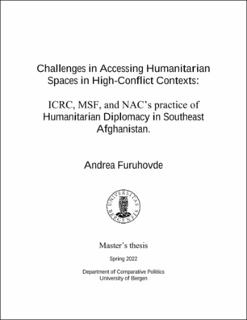| dc.contributor.author | Furuhovde, Andrea Beate | |
| dc.date.accessioned | 2022-08-01T23:53:27Z | |
| dc.date.available | 2022-08-01T23:53:27Z | |
| dc.date.issued | 2022-06-22 | |
| dc.date.submitted | 2022-08-01T22:00:27Z | |
| dc.identifier.uri | https://hdl.handle.net/11250/3009673 | |
| dc.description.abstract | The nature of the practice of Humanitarian Diplomacy makes it a difficult subject for scholars to study and generalize and therefore has resulted in the field being dominated by single case-studies. This is especially true for high-conflict contexts. It is difficult to study humanitarian diplomacy separated from the context in which it is practiced. However, there is a lack of case-studies that contain a comparative element that can be used to determines the ability to successfully generate humanitarian spaces. This thesis aims to close that research gap by doing a comparative case-study of three non-state humanitarian actors: The International Committee of the Red Cross, Médecins Sans Frontières, and the Norwegian Afghanistan Committee. These three actors all delivered humanitarian assistance within the same high conflict context in Afghanistan. Specifically in the Southeast region between 2001 (beginning of US invasion), and up until August of 2021 (recent US withdrawal and Taliban takeover). The thesis attempts to compare the three actors’ ability to use humanitarian diplomacy to access humanitarian spaces. The aim of which is to successfully access people in need on both sides of the conflict, including rural contested areas. In doing this, it is the aim of this thesis to uncover what factors determined the ability of the actors to gain access. Results presented here were based on in-depth interviews conducted with humanitarian workers of each organization, with the purpose of better understanding the challenges they face in the field. The thesis finds that one cannot generalize the ability to use humanitarian diplomacy within contexts characterized as “high-conflict contexts” due to lack of ability to assure the safety of humanitarian workers and recipients of assistance. The thesis also finds that the type of humanitarian scope largely determines actor’s capacity and prospect to work in rural areas. However, humanitarian actors may find indirect ways to mitigate security risks, understood as “Humanitarian openings”. Although recent events resulted in a sudden change to the course of the conflict; with a deeper understanding of the conflict dynamics in Afghanistan prior to the Taliban takeover in August 2021, a new way of framing humanitarian assistance in high-conflict contexts is proposed. | |
| dc.language.iso | eng | |
| dc.publisher | The University of Bergen | |
| dc.rights | Copyright the Author. All rights reserved | |
| dc.subject | emergency humanitarian assistance | |
| dc.subject | Furuhovde | |
| dc.subject | humanitarian spaces | |
| dc.subject | ISAF | |
| dc.subject | high-conflict context | |
| dc.subject | MSF | |
| dc.subject | NATO | |
| dc.subject | armed non-state actor | |
| dc.subject | USA | |
| dc.subject | insurgency | |
| dc.subject | Afghanistan | |
| dc.subject | small war | |
| dc.subject | guerilla | |
| dc.subject | humanitarian diplomacy | |
| dc.subject | armed conflict | |
| dc.subject | ICRC | |
| dc.subject | civil war | |
| dc.subject | South Asia | |
| dc.subject | ARCS | |
| dc.subject | bistand | |
| dc.subject | NAC | |
| dc.subject | Taliban | |
| dc.subject | humanitarian negotiations | |
| dc.subject | ANSA | |
| dc.subject | Southeast | |
| dc.subject | humanitarianism | |
| dc.subject | INGO | |
| dc.subject | utenriks | |
| dc.title | Challenges in Accessing Humanitarian Spaces in High-Conflict Contexts: ICRC, MSF, and NAC’s practice of Humanitarian Diplomacy in Southeast Afghanistan. | |
| dc.type | Master thesis | |
| dc.date.updated | 2022-08-01T22:00:27Z | |
| dc.rights.holder | Copyright the Author. All rights reserved | |
| dc.description.degree | Masteroppgave | |
| dc.description.localcode | SAMPOL350 | |
| dc.description.localcode | MASV-SAPO | |
| dc.subject.nus | 731114 | |
| fs.subjectcode | SAMPOL350 | |
| fs.unitcode | 15-13-0 | |
